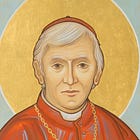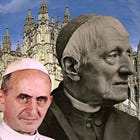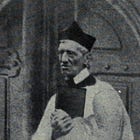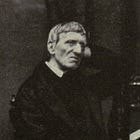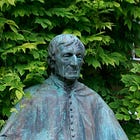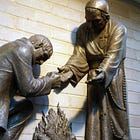Bishop Sanborn, and Cardinal Newman's 'Proof from Conscience'
Bishop Sanborn alleged that Newman saw conscience as an ‘internet connection to heaven’ and that Newman remained a Protestant and proto-modernist. But has he misunderstood the matter?
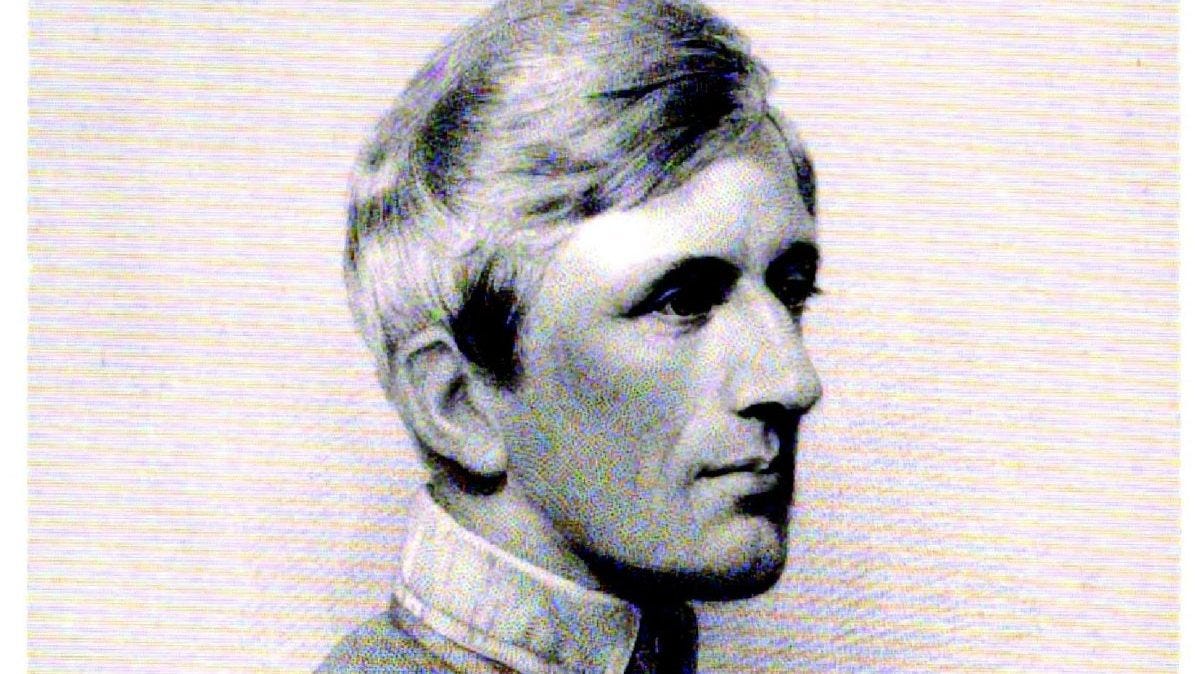
Bishop and Cardinal, Part IIa
Introduction
In the previous piece, I began analysing Bishop Donald Sanborn criticisms of Cardinal Newman, made in a November 2023 reaction video published by his seminary’s YouTube channel.1 This video dealt with the requirements for salvation, and consisted of Bishop Sanborn and an interviewer reacting to numerous clips of an interview between Bishop Robert Barron and Ben Shapiro. The relevant transcript is available in full in Part I.
I have already demonstrated that Bishop Sanborn’s presentation of Cardinal Newman’s idea of conscience – which he condemns as “precisely modernist” – is inaccurate and unfair. This is so, not least because the chapter of Newman’s work in question makes clear that he understood conscience in “precisely” the same way as the Bishop does himself.
At the time of publication (November 2024), this video remained online, and those associated with Bishop Sanborn continue to circulate it. In March 2024, the Bishop appeared to moderate his language when answering a question about this present series; taking this as the closest the Bishop might come to a retraction, we redacted the three articles, removing mention of his name.
Regrettably, Bishop Sanborn has chosen to renew the same criticisms in an August 2025 video and newsletter. We consider the vindication of Newman’s good name to be important as a matter of justice, and because Sanborn’s narrative, adopted from the distortions of the modernists, is injurious to the Church (we touched on some of the reasons for this in the previous part). As a result we are publishing an updated and un-redacted version of the three articles.
In this second part, we will consider whether Newman’s argument for the existence of God, based on conscience, is susceptible to accusations of modernism.
The Bishop did not address this argument in his November 2023 video; nonetheless, Newman’s discussion of this point is helpful for understanding his other point. We also note that Sanborn has raised this proof in his August 2025 newsletter in the following terms:
“His principal error was the primacy of conscience. For Newman, conscience was the voice of God. He says that the very existence of God is known by the voice of conscience, which dictates to us what is right and wrong.”
The insinuation here is that the idea of a proof for the existence of God based on conscience is intrinsically and obviously problematic. Cardinal Lépicier, who criticised Newman’s thought, also appears to have misunderstood the argument being made: he himself rejects what he presents as Newman’s argument, whilst also affirming, in substance, what Newman himself argues.2
Further, as we have already seen that Bishop Sanborn is mistaken in his characterisation of how Newman understood conscience, it is prudent for us now to be on our guard with regard to his criticisms, and consider whether the he may have also misunderstood other relevant matters.
In the process of considering these points, we shall see that Bishop Sanborn’s accusations – that Newman’s ideas were “modernist,” and that he “remained a protestant” – are based on a lack of knowledge of the subject at hand, as well as being calumnious and unjust to Newman, and injurious to the Church which has honoured him for decades.
Bishop and Cardinal Mini-Series
Part I: Is Cardinal Newman’s idea of conscience ‘precisely modernist,’ as Bishop Sanborn claims?
Part IIa: Bishop Sanborn, and Cardinal Newman’s ‘Proof from Conscience’
Part III: Bishop Sanborn’s attempt to link Cardinal Newman with Baron von Hügel
Conscience as a proof for God’s existence
As stated, Newman treats conscience as a proof for God’s existence. This is sometimes interpreted, by those prejudiced against him, as being an example of him endorsing the modernist theory of “vital immanence,” condemned by St Pius X.
This theory held that religion and dogma arise out of an internal sense. Treating this as in any way similar to Newman’s proof from conscience is to miss the point of one, or both, ideas. Far be it from us to suggest that Bishop Sanborn has missed the point of modernism, against which he has struggled for his entire life; however, this does leave the possibility that he has missed the point of Newman’s argument.
First, let us return to Newman’s stated definition of conscience as given in the chapter in question:
“I observe that conscience is not a judgment upon any speculative truth, any abstract doctrine, but bears immediately on conduct, on something to be done or not done.
“‘Conscience,’ says St. Thomas, ‘is the practical judgment or dictate of reason, by which we judge what hic et nunc is to be done as being good, or to be avoided as evil.’ Hence conscience cannot come into direct collision with the Church’s or the Pope’s infallibility; which is engaged in general propositions, and in the condemnation of particular and given errors.’”3
As stated, this is the definition of conscience which Newman gives in the chapter. His discussion of conscience in the chapter is based on this definition, and not on any purple passage or figurative language. In a similar way, Newman’s proof for the existence of God based on this definition, and not anything else.
The proof is expressed at length in Newman’s The Grammar of Assent. Bishop O’Dwyer – in a work praised by St Pius X – summarises the first stage of the argument:
“It starts with the assumption that men have a conscience—a faculty* which yields specifically distinct feelings* in presence of human actions; that these feelings include a moral sense which distinguishes right from wrong by a judgment of the reason, and moreover a moral dictate which commands some actions, and forbids others, and it is in this respect that it seems to Newman to point to the existence of God.”4
(*We should not be distracted by the use of the word “feelings” here. He is not saying that Newman equated conscience with feeling; rather, that conscience, which is a mental act, yields distinct feelings in the presence of the acts which it judges. Similarly, by calling it a “faculty” Bishop O’Dwyer is evidently speaking in a shorthand: there can be no doubt that Bishop O’Dwyer understood what conscience is.5)
O’Dwyer continues:
“As a dictate it commands and forbids, carries a sanction in the pain which follows its violation, and these feelings, in Newman’s opinion, carry the mind forward to some Being outside itself, which “vaguely reaches forward to something beyond self, and dimly discerns a sanction higher than self for its decisions”. […]
“The case stands thus: As to our power of distinguishing right from wrong Newman asks, where does it come from? Then the human mind not only discriminates right from wrong, as the eye discriminates between different colours, but together with the difference, recognises the further note of authority. Whence, he asks, comes its sanction? These things point to the Author of the moral law, as its ultimate source and its true sanction. […]
“That is Newman’s argument. Looking into his own mind a man sees, not God, not religion, but the mind’s own operations, which, by their very nature, lead him to infer the existence of their Author, and that under aspects which appeal to the imagination and minister to its functions.
“The whole process is carried on, from first to last, under the direction and control of the intellect. Its suggestions and presentations feed and sustain the imagination and feelings. Sentiment, and feeling, and all such activities of the human mind are, in themselves, blind, and may lead us in any direction, the wrong as well as the right, unless they are guided and regulated by the intellect.”6
This passage calls for three observations.
First, we must note that this argument is presented as a proof for the existence of God, and is based on the use of natural reason. It does not refer to coming to know the content of divine revelation, as Bishop Sanborn alleges in his video and elsewhere.
Second, the modernists refused even to affirm God’s existence with certainty. This is why Pope St Pius X wrote:
“Modernists place the foundation of religious philosophy in that doctrine which is commonly called Agnosticism. According to this teaching human reason is confined entirely within the field of phenomena, that is to say, to things that appear, and in the manner in which they appear: it has neither the right nor the power to overstep these limits.
“Hence it is incapable of lifting itself up to God, and of recognizing His existence, even by means of visible things.”7
This was a rejection of the teaching of Vatican I, which dogmatically defined that God’s existence was knowable through reason alone:
“If anyone says that the one, true God, our creator and lord, cannot be known with certainty from the things that have been made, by the natural light of human reason: let him be anathema.”8
This dogma was reaffirmed in The Oath against Modernism.
Quite unlike the modernists, Newman held that this proof from conscience – along with other traditional proofs, such as the “Five Ways” – is an argument, based on natural reason and the things that have been made, which affirms God’s existence with certainty. One does not have to like this argument, or prefer it to the “Five Ways” – but to accuse it of “modernism” is inaccurate.
Third, even if this proof did have some relevance to divine revelation (as opposed to God’s existence), appealing to internal motives of credibility is not per se illegitimate – although it can become so, if these motives are given priority over the external ones. But, in any case, Newman does no such thing. Further, Benard explicitly points out that his contributions were “not a substitute for traditional apologetics” but rather auxiliary and even preliminary to them.9
And this, in turn, is a first step to understanding his comment about offering a toast to conscience before the Roman Pontiff. Conscience is, in a certain sense, preliminary to the act of submission to the Roman Pontiff. It is conscience which commands a man to make the assent of faith in the face of both external and internal motives of credibility – not because he feels the faith to be true, but because he comes to know it to be obligatory. As O’Dwyer summarises:
“For Newman himself, that knowledge, as we have seen, originates in the very intimations of duty by conscience, and he holds that, as these intimations are more fully obeyed, not only does the knowledge of God from within become clearer, and His image more vividly reflected from the external world, but the whole man, intellect, will, and feelings comes more fully under the influence of religion; the sense of sin is borne in more oppressively upon him; the recognition of his own corruption more deeply pierces him; in a word, he finds himself in the frame of mind described by St. Paul, in chap. vi. of the Romans, of one who felt the conflict between his higher and his lower nature, in which he cries out quis liberabit?
“And it is Newman’s view that, if to a man so disposed, the truth of Our Lord’s Gospel were presented, he would respond to it, or rather he would have the natural preparation for responding to it, not merely by a dry assent of the intellect, but by an act of moral duty which, by God’s grace, would include intellect, and will, and heart, that is the whole man.”10
Anyone who would call this ‘modernism’ would be advised to re-read Pascendi Dominici Gregis.
This discussion brings us back to the chapter of the work to which Bishop was referring (the Letter to the Duke of Norfolk).
While there is considerably more to be said about the “after-dinner toasts” – which we will address in the next part – we must first turn to his portrayal of conscience as “the voice of God” and “the aboriginal Vicar of Christ.”
Newman’s use of figurative language
In the relevant chapter of the Letter to the Duke of Norfolk – the work to which Bishop Sanborn was referring – Newman refers to conscience as “the voice of God in the nature and heart of man.” Is this a legitimate way of speaking, even figuratively?
We have already seen above, and in the previous part, that Newman’s conception of conscience is correct, that it follows St Thomas, and that it is the same as that held by Bishop Sanborn himself.
By calling conscience “the voice of God,” Newman is using figurative language to say that the imperative command and effect of conscience bear witness to the natural law, which is the eternal law of God as imprinted on rational creatures, and whose sanction is derived from God.
In this sense – the sense evidently intended by the speaker, which St Thomas and St Hilary say takes precedent over words themselves11 – it is quite properly called “the voice of God,” and even a communication from God to the rational creature – not in some sentimental or mystical sense, but precisely in the natural, intellectual sense that St Thomas and others explain it.
Newman’s conclusion – that all this leads to proof of God’s existence – flows from observations on the nature of conscience itself, as properly understood. He is discussing the act of the intellect judging acts to be done here and now, and the natural law, knowable through reason.
Further on, Newman uses other figurative language which the bishop finds offensive:
“Conscience is not a long-sighted selfishness, nor a desire to be consistent with oneself; but it is a messenger from Him, who, both in nature and in grace, speaks to us behind a veil, and teaches and rules us by His representatives.
“Conscience is the aboriginal Vicar of Christ, a prophet in its informations, a monarch in its peremptoriness, a priest in its blessings and anathemas, and, even though the eternal priesthood throughout the Church could cease to be, in it the sacerdotal principle would remain and would have a sway.”12
(The last sentence is hyperbole and talking about what is impossible. How else could someone talk about an ‘eternal’ priesthood passing away? Nonetheless, we should note that Cardinal Lépicier, although opposing himself to a mistaken understanding of Newman’s argument, makes the same point.13)
From this, we can see that he is not trying to say that mystical conceptions of conscience prove God exists, because we can feel or hear it to be so. Even less is he talking about conscience mediating matters of supernatural revelation – in fact, he specifically excludes this (along with the truth of all other speculative propositions), as we have already seen.
It would be very mistaken to take this figurative language and to conclude, against all actual evidence, that Newman is suggesting that conscience is what the Bishop calls “some special faculty in your brain or in your intellect or something like that where you get signals from heaven. Some sort of telephone to Heaven about what’s true and what’s false.”
Conclusion
In this part, we have seen that, far from being modernist in any form, Newman’s “Proof from Conscience” is a legitimate means of proving God’s existence. We have also seen that there is nothing objectionable in referring to conscience as “the Voice of God,” provided that the meaning is clear – as it is in Newman’s writing. We have also demonstrated that Bishop Sanborn’s criticism of Newman on these grounds is seriously mistaken.
Having considered whether conscience can be described as the “Voice of God,” in we will next consider Newman’s comments about the Papacy in this chapter.
However, before concluding this piece, let us also note that St Thomas Aquinas uses uses similarly figurative language to personify conscience:
‘[C]onscience is said to witness, to bind, or incite, and also to accuse, torment, or rebuke.’14
This language brings us to the double-standard commonly employed in the anti-Newman myth. While Newman is condemned for calling the conscience “the voice of God,” we find St Peter Damian speaking in a similar way in The Book of Gomorrah – personifying conscience, and even calling it “the interior Judge”:
“If, however, this little book might have reached the hands of anyone whose conscience cannot at all bear what is written above, and is by chance displeased by it, and accuses me of being a traitor and an informer of the crimes of my brothers, he should know that I have sought with all zeal the favor of the interior Judge, but do not fear the hatred of the depraved or the tongues of detractors.”
Similarly Lépicier, while mistakenly believing that he is opposing Newman’s argument, also personifies conscience in a similar way to St Thomas, and further writes:
“[I]t may be noted that conscience is called the voice of God, and its testimony is held to prove that God exists and has forbidden certain acts, precisely because it bears witness that there exists a certain moral order by which we are commanded both to do good and to avoid evil.”
Thus, there seems to be no reason to condemn Newman for personifying conscience, or using figurative language.
But perhaps the specific language – namely calling conscience the “aboriginal Vicar of Christ,” and saying that one would “toast” conscience before the Pope – is a problem?
This will be the subject of the next part.
Originally, this and the next part formed one article. In the process of updating and un-redacting these articles in 2025, it has been separated into two due to the length.
HELP KEEP THE WM REVIEW ONLINE WITH WM+!
As we expand The WM Review we would like to keep providing free articles for everyone.
Our work takes a lot of time and effort to produce. If you have benefitted from it please do consider supporting us financially.
A subscription gets you access to our exclusive WM+ material, and helps ensure that we can keep writing and sharing free material for all.
You can see what readers are saying over at our Testimonials page.
(We make our WM+ material freely available to clergy, priests and seminarians upon request. Please subscribe and reply to the email if this applies to you.)
Subscribe to WM+ now to make sure you always receive our material. Thank you!
Read Next:
Bishop and Cardinal Mini-Series
Part I: Is Cardinal Newman’s idea of conscience ‘precisely modernist,’ as Bishop Sanborn claims?
Part IIa: Bishop Sanborn, and Cardinal Newman’s ‘Proof from Conscience’
Part III: Bishop Sanborn’s attempt to link Cardinal Newman with Baron von Hügel
Books
Newman – Letter to the Duke of Norfolk
Newman – An Essay on the Development of Christian Doctrine
Newman – The Idea of a University
Bishop E.T. O’Dwyer – Cardinal Newman and the Encyclical Pascendi Dominici Gregis
Fr E.D. Benard – A Preface to Newman’s Theology
C. Michael Shea – Newman’s Early Roman Catholic Legacy, 1845-1854
Articles
See our Newman archive here – with some highlights below:
Follow on Twitter, YouTube and Telegram:
MHT Seminary, ‘Questions for the Rector | Ep. 5: The Barron/Shapiro Interview’, YouTube, 7 Nov 2023. The comments start around the 12 minute mark. I will not be continually offering references and timestamps – this should be sufficient.
See n. 1 of the first part for a few brief comments about this video’s treatment of the topic of salvation.
John Henry Newman, Letter to the Duke of Norfolk, 1875. Published in Certain Difficulties felt by Anglicans in Catholic Teaching Considered, Vol. II, p 256. Longmans, Green, and Co., London, 1900. Available at https://www.newmanreader.org/works/anglicans/volume2/gladstone/section5.html
Bishop E.T. O’Dwyer, Cardinal Newman and the Encyclical Pascendi Dominici Gregis, p 11-2. Longmans, Green and Co., London 1908.
In the video, the Bishop seems to suggest that Newman believed that conscience is a faculty.
In fact, as we have seen throughout the chapter, Newman understands, with St Thomas, that conscience is an act. This is implicitly or indirectly expressed throughout the chapter in question, and stated explicitly in An Essay on the Grammar of Assent, where he writes:
“Conscience has a legitimate place among our mental acts.” cf. p 105.
https://newmanreader.org/works/grammar/chapter5-1.html#section1
Ibid. 12-4.
Pascendi, n. 6
Fr E.D. Benard, A Preface to Newman’s Theology, 21. B. Herder Book Co., London, 1945.
O’Dwyer 28-9
“Hilary says (De Trin. iv): ‘The meaning of what is said is according to the motive for saying it: because things are not subject to speech, but speech to things.’ Therefore we should take account of the motive of the lawgiver, rather than of his very words.”
St Thomas Aquinas, Ia IIae, Q96, A6.
Newman 248-9
“But that this moral order is actually founded in the wisdom, justice, and holiness of some first being, subsisting in itself and really distinct from the whole universe of things, whom we call God, is known from elsewhere than from conscience itself. Hence also we adequately apprehend the deformity of our actions even before our knowledge of the actual precept or prohibition of God.
“Nay rather, if, by impossibility, there were given some region in which the notion of the existence of God, not to say of his attributes, was absent, still within the inmost recesses of the human heart the voice of conscience would resound, now torturing or tormenting, now reproaching or goading.”
Lépicier seems to understand Newman’s “sacerdotal principle” as referring to the existence of God, the consciousness of which would remain, even if we had no knowledge of God. But this is to misconstrue Newman’s entire argument. On the contrary, it is most clear that “the sacerdotal principle” to which Newman is referring is conscience’s “peremptoriness” in judging the morality of individual actions – as Lépicier says, “now torturing or tormenting, now reproaching or goading.”
St Thomas Aquinas, Summa Theologiae I, Q79 A13.



